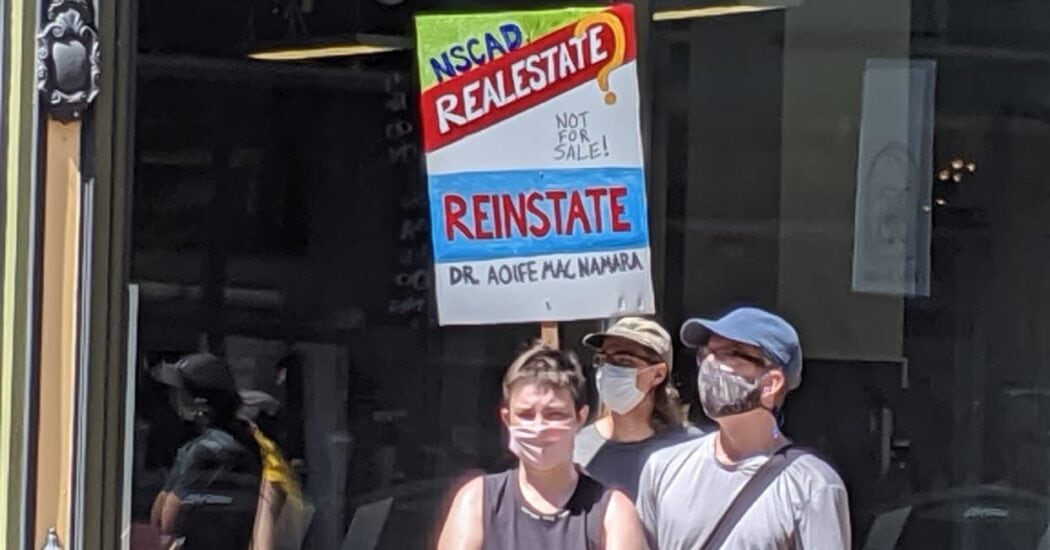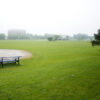
There is something rotten in the state of NSCAD, and the rot is centered at the top. It is a Necrotizing fasciitis that takes root and grows in the dark, and the time has come to shine some sunlight upon the problem. We have also seen some disturbing evidence that the role played by the NSCAD Alumni Association leadership in recent manifestations has failed to not only resist and illuminate the problem, but has, to all available evidence, helped to further entrench it.
The Nova Scotia College of Art and Design (NSCAD) is ailing. Once the most important Art College in North America, and one of the leading art education institutions in the world, it has not only fallen on hard and precarious times, but it is facing an existential crisis. Since the 1970s, NSCAD has pulled off a series of Houdini-like escapes from disasters and take-overs, but no one could have foreseen that the greatest threat would come—as it has—from within its own Board of Governors (BoG); a threat apparently aided and facilitated by elements amongst the alumni.
NSCAD’s strengths and resources are significant: they lie in the people it attracts and in the facilities and property it owns. Sadly, however, recent years have seen significant mismanagement of those strengths and resources by the NSCAD Board—the very board entrusted to “ensure that the mission and vision of the University is fulfilled, strategic direction is assured, [and the] financial stability is safeguarded” (to quote a recent Open Letter from the current Board Chairperson).
The NSCAD Faculty, one of the best-regarded arts faculties on the continent, was forced into strike action only just last year—a strike that was put down by the high-handed actions of an intransigent and irresponsible Board. The NSCAD students have also been consistently shortchanged by a Board of Governors clearly and demonstrably unqualified to oversee the health and operation of a Fine Art and Design institution. NSCAD’s institutional staff, too, have been treated as an expendable low-wage commodity that can be discarded and easily replaced. All of these key participants in the Institution— the human dimension of the Institution—have been treated with exceptional shabbiness by the Board.
Recently, however, a new attack surfaced, in the form of an “unsolicited offer” to the Board—an “offer” to relieve NSCAD of some of the most valuable land and buildings in Eastern Canada, recompensed at considerations far below market or potential values. We are told that it is pure coincidence that the offer was made by an organization that keeps certain key—albeit unnamed— members on the Board on highly lucrative retainers. We are also told that these paid operatives—who
have bought–and–paid–for responsibilities to the bidder, and who are thus, legally, creatures of the bidder—somehow have only the best interests of NSCAD at heart and can somehow unproblematically divide their interests. The untruth of such a fairytale of neutrality is palpable, but the fact that this cover story was even floated fits the recent historical pattern of Board malpractice and malfeasance.
In point of fact, in Nova Scotia it is a conflict of interest for any legal representative, officer, or agent to serve both sides in a transaction. Even a hint of the appearance of any such a conflict of interest must, at the very least, attract scrutiny as to its ethical integrity. This matter should and must be brought to the attention of the provincial Bar Association for investigation.
A strikingly similar fairytale has been told by the Board Chairperson, in a document on the NSCAD website, about the most recent sudden, summary, and entirely unexplained firing of the NSCAD President, Dr. MacNamara. It was well known that MacNamara was aware of the rot in the Board; that she was planning an initiative to clean up the institution’s governance; and that she had dismissed the notorious “unsolicited offer” as absurd. However, according to the story circulated by the Board—and specifically above the signature of Louise-Anne Comeau (https://nscad.ca/bog-message-to-the-nscad community/)—there is nothing to see—no possible conflict—in the surprise dismissal. It seems that Ms Comeau expects us to believe this despite the wide public knowledge of her Board’s incompetence; despite the threat MacNamara posed to her Board’s power; and despite clear and obvious conflicts of interests amongst members of her Board in proposing shady high-stakes financial transactions. The only rationale or defense offered is a protestation of “confidentiality.”
What is this “confidentiality?” Whom does it serve? In normal circumstances it protects the interests of the institution, and facilitates open debate on points of policy. It can also, however, serve to cover up self-serving and other malfeasance, and can be employed as a weapon to silence individuals who, while in the minority on the Board, recognize and object to untoward machinations. It is significant, but not perhaps always clear to an individual being threatened against contemplating or committing “breaches of confidentiality,” that no pledge of confidentiality can stand as either threat or protection when used to hide unlawful actions, and that, furthermore, Whistle-blower protections do not require the disclosed actions to be proven, only reasonably believed to have taken place.
What are the immediate facts? For one, it is indisputable that Dr MacNamara, the now-former President of NSCAD, was a capable and independent executive who had shown her intention to, among other things, reform the toxic BoG and to thwart the plan to strip NSCAD of its most valuable real estate assets. It is also well known that she was dedicated to implementing realistic and broadly
supported initiatives to build a diverse, inclusive and accountable culture, practice and process. It is known, too, that the transparently punitive motion to fire MacNamara was one for which NO justification was offered or debated, and furthermore was put up for a vote in a highly irregular, surprise addition to a Board meeting agenda. It has every appearance of a Night of Long Knives move to remove what someone perceived as a threat.
Clearly, the actions of the current NSCAD Board of Governors have given ample evidence of a need for investigation, and also fully justified recent public calls for the entire NSCAD Board to be sacked —at least until such time as a thorough and public investigation has exonerated any individuals on that Board.
What, then, about the remark in the opening of this letter about the role the NSCAD Alumni Association has played in this? It appears to have taken two forms: on the one hand, acquiescence or collusion in objectionable Board actions, and on the other a failure to communicate with the body of Alumni in whose names the acquiescence or collusion took place. What part did the Alumni representatives actually play, and why was the Alumni membership not informed? These questions remain unanswered even at this late date.
The publicly established facts are that there are two Alumni Association “representatives” that sit on the NSCAD Board—one of which also sits on the doubly–confidential Executive Board—and that when the question of the MacNamara firing was called, the votes of the Alumni Association representatives were split: one for and the other against. Interestingly, the alumnus who voted to dismiss was the one sitting on the BoG Executive—that is, the one most close to the center. There is no real information about why either vote was cast in the name of the alumni.
In addition, the Presidential firing took place some months ago. When the firing became known, the NSCAD Faculty quickly announced that they had no confidence in the BoG. Similarly, NSCAD students have often, loudly, and imaginatively expressed their collective and individual dismay at both the firing and at the high–handed, irregular, and possibly illegal manner in which it was carried out. They have done so through public actions of various sorts, such as marches, petitions, letter–writing campaigns, posters, and on social media, as well as in news items on the radio and in the press.
In that same period of time, the NSCAD Alumni Association did not respond. Months later, on Tuesday, 8 September, the NSCAD Alumni Association held an on–line Annual General Meeting (AGM), attended by an unprecedented record number of participants from across North America and around the world. The great majority attended because of concerns about the existential issues facing
NSCAD. The Chair of the meeting—the same individual who (until just recently) represented the Association on the Executive of the BoG—employed a variety of procedural tactics to avoid the topic of interest, and was, in fact, rushing to close the meeting (and close the meeting’s Zoom session), when attendees arose and demanded that this matter be discussed.
Over the next two plus hours, a few things became abundantly clear to many Alumni, myself included: that the Alumni leadership was not acting in NSCAD’s best interest; that the Alumni Association reps were not acting in accord with the views and wishes of the Alumni; and that the current Association reps were disinclined to change their behaviors and actions in dealing with the BoG. In point of fact, they flatly refused to even inform the Association members about BoG proceedings and debates or of their inputs to, and participations in, BoG actions—inputs and participations supposedly taken in the name of the Association members.
There were two results from that open and wide-ranging discussion:
1. A motion was passed that the members of the Alumni Association have no confidence in the President of Alumni Association.*
2. An Ad–Hoc Committee was struck to provide guidance to the Alumni Association representatives on the NSCAD BoG.
There was also a lively discussion a week later at the 16 September meeting of the Ad–Hoc Committee formed at the AGM. Chaired by the Association Vice President, it made very little progress on instructing the Association representatives—only one of which actually attended. This “representative” appeared to be far more concerned with protecting BoG “confidentiality” than in representing his constituents. The weak excuses that met any suggestion for even polite—let alone vigorous— representation on the BoG were quite wearying, and even the promises that the advisory committee’s views would be mentioned were unconvincing. It is baffling how anyone could think that a refusal to carry any message or initiative demanding a reversal or change or direction by the NSCAD Board could be considered appropriate behavior for a representative. In explanation of that refusal, the Ad– Hoc Committee heard pleas that nothing can be done, that things just are as they are, or that we have to work with these people. This sort of flaccid representation is tantamount to wrinkling one’s brow and holding one’s nose at a foul odour, but refusing to clean the canine soil from one’s shoe.
Finally, it was learned, at the Association meetings mentioned, that a report from the NSCAD Alumni Association was to be submitted to the BoG by close of business on 17 September—the day after the 16 September meeting of the Ad–Hoc Committee. It transpired that the report was to be composed in
secret session by the Alumni Association Executive—the Executive in which the Association members had so recently expressed no confidence. Asked about this report in the 8 September meeting, the (then) Association President several times flatly refused to share that report with the members either as a draft or as a final report. This refusal was reiterated in the 16 September meeting by the Association Vice President (now President). This was despite the fact that the committee was meeting expressly to shape that report and the positions to be taken on it and other matters. The Alumni Association Executive appeared to be hiding behind unjustifiable “confidentiality” and artificially manufactured deadlines, much like the NSCAD Board of Governors Executive.
The NSCAD BoG and Administrative Executive normally appear to view the Alumni Association as their pet creature: good for publicity and fund–raising, but not suffered to make inconvenient noises. This subsidiary status is widely recognized by the alumni, and that recognition no doubt contributes
significantly to the relative neglect of the Association by the alumni. However, when the normal guardians of the institution have so often and so consistently shown themselves to be so incompetent and self–serving, and so recently shown themselves to be such an existential threat to NSCAD, the alumni cannot stand silent. We have Heads and Hearts and Hands, and we must use them to help clean the Augean stables the self–serving Board of Governors have made of what Garry Kennedy called The Last Art College.
Thus, the Alumni must take charge of our Association, and use it as the platform from which we act. To quote the late David Graber, a founder of Occupy Wall Street: “The world is something we make, and could just as easily make differently.”
We call for the current NSCAD Board of Governors to be removed from all roles of trust. We call on the responsible Ministries of the Nova Scotia Government to publicly investigate this current Board, and to play an honest part in reforming it with new and more suitable members. We call on the Nova Scotia Bar Association to investigate the activities of their members involved with the current NSCAD
Board of Governors, and to take action where appropriate. We call for the invitation of the unjustly removed NSCAD President, Dr Mac Namara, to return to the University to work with the new Board, and to carry forward the widely–welcomed plans she was forced to abandon.
We also call for a house–cleaning in the Alumni Association. Since mid September—in personal communications and through a Facebook post—we learned that Mr Jones is now the President of the Alumni Association, with Jeremy Tsang as VP. While this small change may be a first step towards house–cleaning, we have yet to see the report that was delivered to the BoG, or hear anything about
how the “concerns we discussed [were] share[d …] with the Board.” Nor has what has been heard at all encouraging. The Association’s new President’s communications fail to refer to the issues raised at the either of the Association’s recent members meetings, and only obliquely and unconcernedly mentions what sounds like yet another high–handed switcher-oo by the NSCAD BoG over the election of new BoG members. The letters are instead filled with Hello Kitty level references to the need to “work together to enhance the reputation of the university,” or to praising gradualist BoG changes that fail to disrupt entrenched power or address crucial problems.
This just isn’t enough—not enough action and not enough communication. Our confidence, of late, has so badly deteriorated that we really need to start seeing some evidence.
* That the Alumni Association President was not instantly removed at the 8 September meeting was only because the members were misinformed by the Secretary about the Association Bylaws. It has since come to light that other clauses in that document do indeed grant that power to the members. It remains unclear—setting aside earlier abuses of the rules of procedure by the disgraced meeting chairperson—if this misstatement of the procedural rules was accidental.
See also: The place to draw the line is here – On NSCAD and the real threat to universities
With a special thanks to our generous donors who make publication of the Nova Scotia Advocate possible.
Subscribe to the Nova Scotia Advocate weekly digest and never miss an article again. It’s free!



